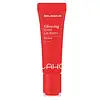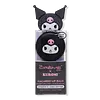What's inside
What's inside
 Key Ingredients
Key Ingredients

 Benefits
Benefits

 Concerns
Concerns

 Ingredients Side-by-side
Ingredients Side-by-side

Polyisobutene
Petrolatum
EmollientParaffinum Liquidum
EmollientDiisostearyl Malate
EmollientMicrocrystalline Wax
Emulsion StabilisingEthylene/Propylene/Styrene Copolymer
1,2-Hexanediol
Skin ConditioningSilica Dimethyl Silylate
EmollientParfum
MaskingCI 15850
Cosmetic ColorantTitanium Dioxide
Cosmetic ColorantSorbitan Sesquioleate
EmulsifyingCI 45410
Cosmetic ColorantCI 15985
Cosmetic ColorantCI 77499
Cosmetic ColorantCaprylyl Glycol
EmollientPrunus Amygdalus Dulcis Oil
Skin ConditioningHelianthus Annuus Seed Oil
EmollientMacadamia Ternifolia Seed Oil
EmollientButylene/Ethylene/Styrene Copolymer
Tocopheryl Acetate
AntioxidantEthylhexylglycerin
Skin ConditioningBHT
AntioxidantPolyisobutene, Petrolatum, Paraffinum Liquidum, Diisostearyl Malate, Microcrystalline Wax, Ethylene/Propylene/Styrene Copolymer, 1,2-Hexanediol, Silica Dimethyl Silylate, Parfum, CI 15850, Titanium Dioxide, Sorbitan Sesquioleate, CI 45410, CI 15985, CI 77499, Caprylyl Glycol, Prunus Amygdalus Dulcis Oil, Helianthus Annuus Seed Oil, Macadamia Ternifolia Seed Oil, Butylene/Ethylene/Styrene Copolymer, Tocopheryl Acetate, Ethylhexylglycerin, BHT
Hydrogenated Polyisobutene
EmollientBeeswax
Emulsion StabilisingEthylhexyl Palmitate
EmollientOlea Europaea Fruit Oil
MaskingMacadamia Integrifolia Seed Oil
Skin ConditioningButyrospermum Parkii Butter
Skin ConditioningTrihydroxystearin
Skin ConditioningHelianthus Annuus Seed Oil
EmollientDiisostearyl Malate
EmollientEthylene/Propylene/Styrene Copolymer
Tocopheryl Acetate
AntioxidantPolyglyceryl-2 Triisostearate
EmulsifyingMangifera Indica Seed Butter
Skin ConditioningCaprylic/Capric Triglyceride
MaskingButylene/Ethylene/Styrene Copolymer
1,2-Hexanediol
Skin ConditioningBHT
AntioxidantParfum
MaskingCI 77891
Cosmetic ColorantCI 77499
Cosmetic ColorantCI 77742
Cosmetic ColorantCI 15850
Cosmetic ColorantCI 42090
Cosmetic ColorantCI 19140
Cosmetic ColorantCI 15985
Cosmetic ColorantCI 45410
Cosmetic ColorantHydrogenated Polyisobutene, Beeswax, Ethylhexyl Palmitate, Olea Europaea Fruit Oil, Macadamia Integrifolia Seed Oil, Butyrospermum Parkii Butter, Trihydroxystearin, Helianthus Annuus Seed Oil, Diisostearyl Malate, Ethylene/Propylene/Styrene Copolymer, Tocopheryl Acetate, Polyglyceryl-2 Triisostearate, Mangifera Indica Seed Butter, Caprylic/Capric Triglyceride, Butylene/Ethylene/Styrene Copolymer, 1,2-Hexanediol, BHT, Parfum, CI 77891, CI 77499, CI 77742, CI 15850, CI 42090, CI 19140, CI 15985, CI 45410
Ingredients Explained
These ingredients are found in both products.
Ingredients higher up in an ingredient list are typically present in a larger amount.
1,2-Hexanediol is a synthetic liquid and another multi-functional powerhouse.
It is a:
- Humectant, drawing moisture into the skin
- Emollient, helping to soften skin
- Solvent, dispersing and stabilizing formulas
- Preservative booster, enhancing the antimicrobial activity of other preservatives
BHT is a synthetic antioxidant and preservative.
As an antioxidant, it helps your body fight off free-radicals. Free-radicals are molecules that may damage your skin cells.
As a preservative, it is used to stabilize products and prevent them from degrading. Specifically, BHT prevents degradation from oxidation.
The concerns related to BHT come from oral studies; this ingredient is currently allowed for use by both the FDA and EU.
However, it was recently restricted for use in the UK as of April 2024.
Learn more about BHTWe don't have a description for Butylene/Ethylene/Styrene Copolymer yet.
Ci 15850 is the pigment color red. It is an azo dye and created synthetically.
Azo dyes need to be thoroughly purified before use. This allows them to be more stable and longer-lasting.
This ingredient is common in foundations, lipsticks, and blushes. This color is described as brown/orangey red.
It has many secondary names such as Red 6 and Red 7. According to a manufacturer, Red 6 usually contains aluminum.
Learn more about CI 15850Ci 15985 is a dye made from petroleum. It is synthetically created and approved by the FDA for use in foods and cosmetics.
The color of this dye is orange/yellow.
This ingredient can be found in makeup, sun care, and skincare.
Learn more about CI 15985CI 45410 is a synthetic red-pigment and dye.
It often goes by both Red 28 or Red 27; manufacturers label both ingredients as CI 45410.
This dye is commonly found in makeup because it imparts a vivid color. Some types of this dye change color based on pH level and interaction with moisture:
Your skin has a natural pH of around 4.5 - 5.5.
According to the FDA, CI 45410 is not permitted for use in eye products.
Red 27 is a flourescein dye and commonly used as a fluorescent tracer in medicine.
Learn more about CI 45410Ci 77499 is also hydrated iron III oxide. It is created from mixing red and black iron oxides. This helps give shades of darkness to a product.
Iron III oxides are classified as inorganic chemicals for coloring.
Diisostearyl Malate is an emollient and most often used in lip products. It comes from isostearyl alcohol, a fatty acid, and malic acid, an AHA.
As an emollient, Diisostearyl Malate helps create a thin film on your skin to trap moisture in. This helps keep your skin soft and smooth.
We don't have a description for Ethylene/Propylene/Styrene Copolymer yet.
Helianthus Annuus Seed Oil is the oil derived from the seeds of a Sunflower. Sunflower seed oil is non-fragrant. It is an emollient, meaning it helps to soften the skin.
Sunflower seed oil contains many fatty acids. The fatty acids found in sunflower seeds include (from highest amount to least): linoleic acid, myristic acid, palmitic acid, stearic acid, arachidic acid, oleic acid, and linolenic acid.
These fatty acids help the skin create ceramides. Ceramides play a role in repairing the skin barrier.
Helianthus Annuus Seed Oil helps moisturize the skin. This in turn helps the skin look more rejuvenated and smoother.
Sunflowers are rich in vitamin E.
Historians believe Indigenous cultures of North America domesticated sunflowers before corn. Thus they relied on sunflower oil for a variety of uses. One such use is moisturizing skin and hair.
Sunflower seed oil may not be fungal acne safe. We recommend speaking with a professional if you have any concerns.
Learn more about Helianthus Annuus Seed OilParfum is a catch-all term for an ingredient or more that is used to give a scent to products.
Also called "fragrance", this ingredient can be a blend of hundreds of chemicals or plant oils. This means every product with "fragrance" or "parfum" in the ingredients list is a different mixture.
For instance, Habanolide is a proprietary trade name for a specific aroma chemical. When used as a fragrance ingredient in cosmetics, most aroma chemicals fall under the broad labeling category of “FRAGRANCE” or “PARFUM” according to EU and US regulations.
The term 'parfum' or 'fragrance' is not regulated in many countries. In many cases, it is up to the brand to define this term.
For instance, many brands choose to label themselves as "fragrance-free" because they are not using synthetic fragrances. However, their products may still contain ingredients such as essential oils that are considered a fragrance by INCI standards.
One example is Calendula flower extract. Calendula is an essential oil that still imparts a scent or 'fragrance'.
Depending on the blend, the ingredients in the mixture can cause allergies and sensitivities on the skin. Some ingredients that are known EU allergens include linalool and citronellol.
Parfum can also be used to mask or cover an unpleasant scent.
The bottom line is: not all fragrances/parfum/ingredients are created equally. If you are worried about fragrances, we recommend taking a closer look at an ingredient. And of course, we always recommend speaking with a professional.
Learn more about ParfumTocopheryl Acetate is AKA Vitamin E. It is an antioxidant and protects your skin from free radicals. Free radicals damage the skin by breaking down collagen.
One study found using Tocopheryl Acetate with Vitamin C decreased the number of sunburned cells.
Tocopheryl Acetate is commonly found in both skincare and dietary supplements.
Learn more about Tocopheryl Acetate